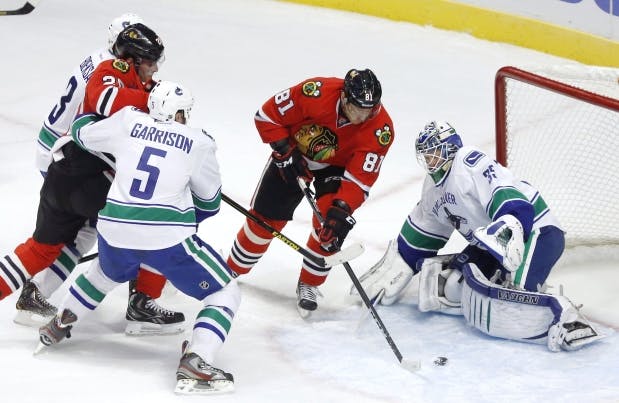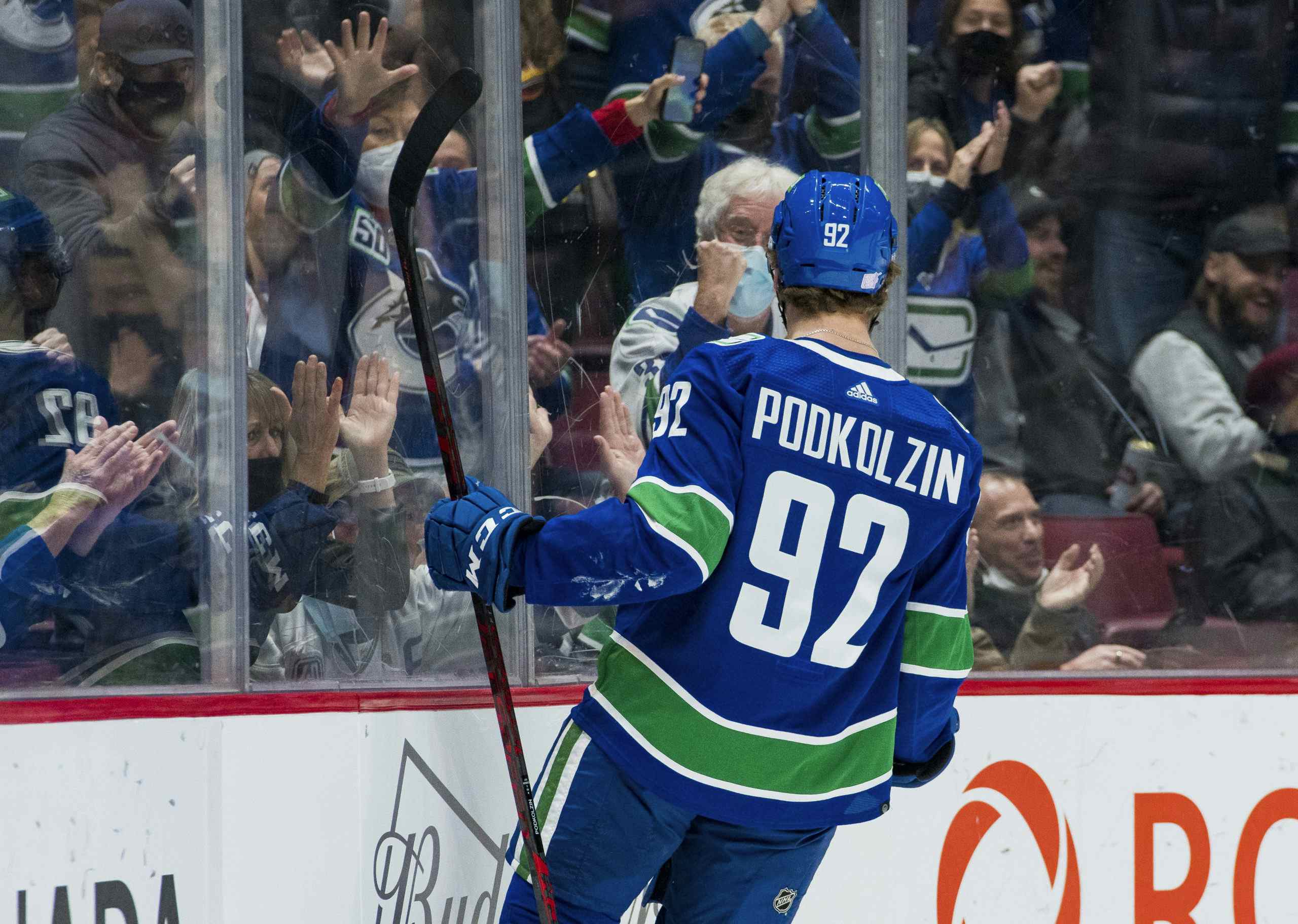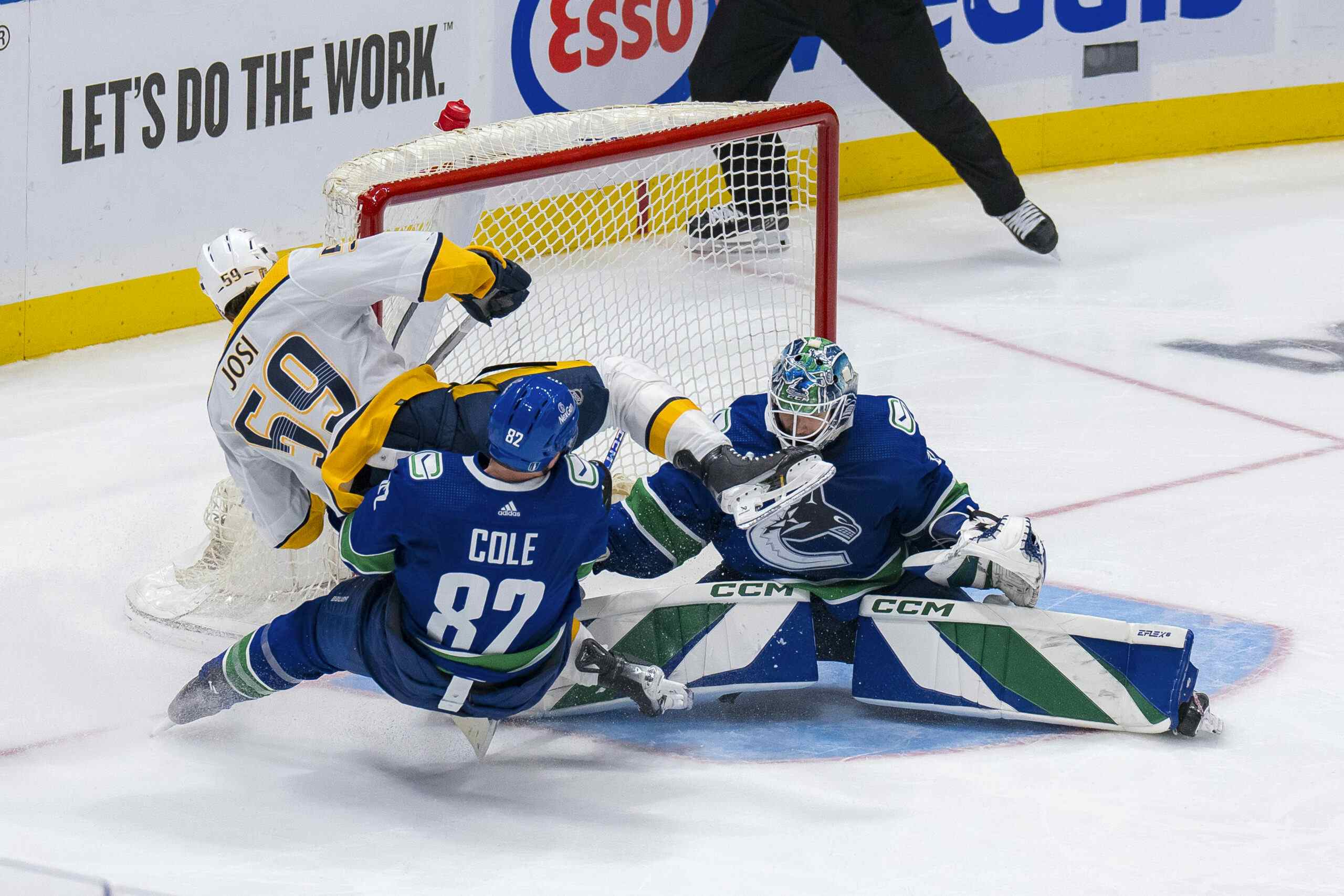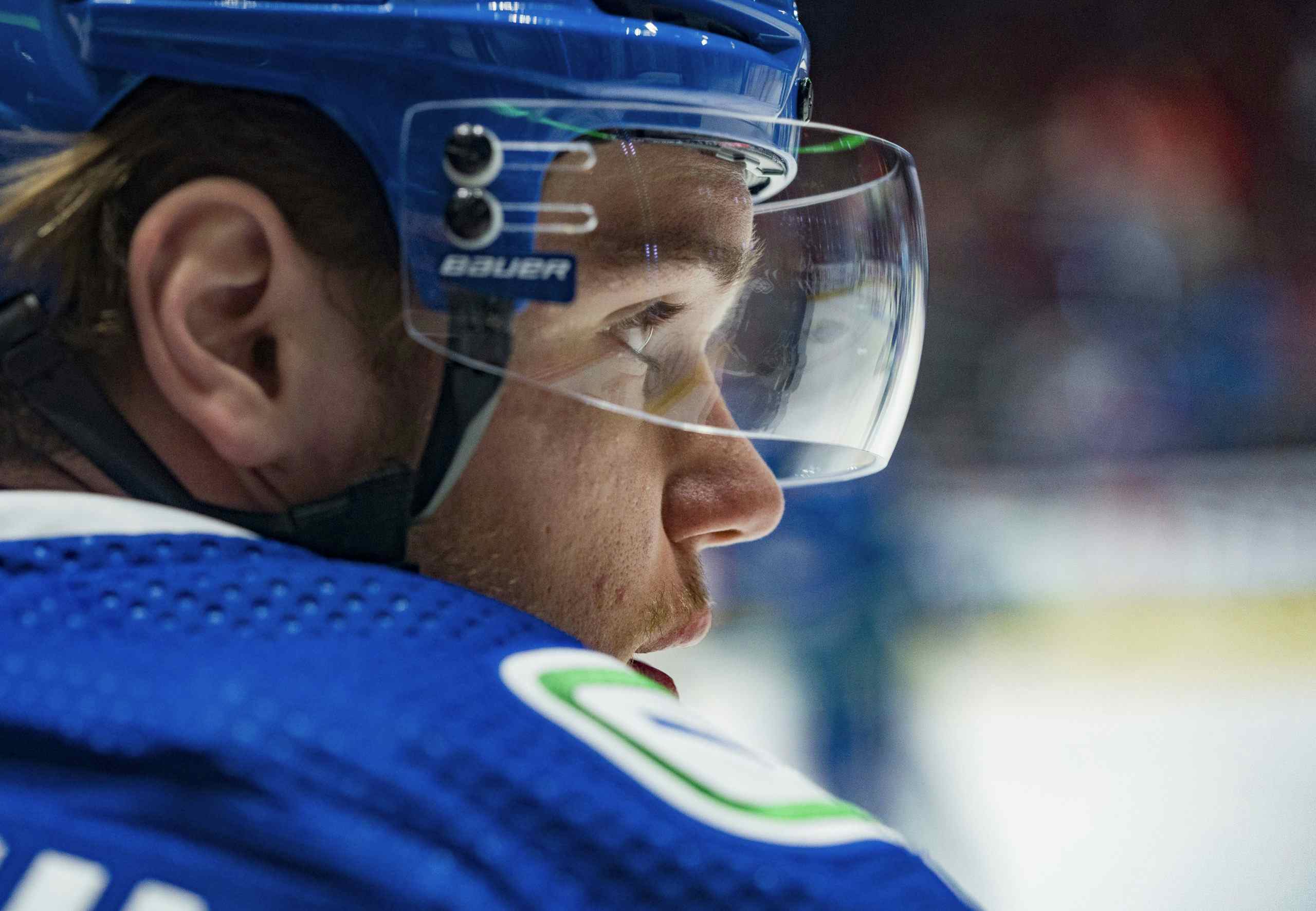On Garrison’s Demotion and why it’s Premature to Abandon the “Edler on the Right Side” Experiment

For Jason Garrison, this defensive coverage is the hockey equivalent of being "posterized."
Photo Credit: Charles Rex Arbogast, AP
Following Tuesday night’s defensive debacle at the Mad-House, Alain Vigneault and Rick Bowness have re-jigged Vancouver’s defensive pairings ahead of Thursday night’s game against the Dallas Stars. In particular, it appears that free-agent signing Jason Garrison – who has had a rough start to his Canucks tenure – has been demoted to the "third-pairing" (note the scare quotes) alongside Keith Ballard, while Vancouver’s usual "ace" shutdown pairing of Dan Hamhuis and Kevin Bieksa have found themselves reunited. Meanwhile fancy-stats darling Chris Tanev will suit up alongside Alex Edler on a slick pairing that, one presumes, will caddy the Sedin twins a fair bit.
Let’s look into what’s going on with Vancouver’s defense through 14 games this season, and try to determine the logic behind Vancouver’s new defensive deployments. Click past the jump.
In the past, I’ve found it useful to break down the underlying numbers along the blue-line before wading into the muck when evaluating formational changes. For example, we’ve observed that Fenwick – an expanded version of plus/minus that counts up all unblocked shot events for and against and the metric we’ve long suspected most closely correlates with the Canucks’ own in-house tracking of scoring chances – has appeared to help clarify why Vancouver’s coaches are making certain decisions in terms of the deployment of their blue-liners.
For example, when Aaron Rome received more minutes than Keith Ballard during the 2010-11 season and we couldn’t figure out why, Cam Charron dug into the data and noticed that the Canucks permitted "Fenwick events against" at a significantly lower rate with Rome on the ice than with Ballard. All of a sudden Alain Vigneault’s preference for Rome’s low-event third pairing stylings made a lot more sense.
I’ve put together a table using data collected at behindthenet.ca. The table is broken down by the individual components that go into the "Fenwick" metric, so, goals against (GA), shots against (SA) and missed shots against (MA) all rated per sixty minutes of even-strength ice-time. I then combined those for a total "Fenwick events against" number (FenA), and I also included "Fenwick events for" (FenF) and a total differential number (FenD) because hockey is a game of ratios, not raw numbers. Let’s take a gander, and then extrapolate what we can from the data:
| Defenseman | GA/60 | SA/60 | MA/60 | FenA/60 | FenF/60 | FenD/60 |
|---|---|---|---|---|---|---|
| Alex Edler | 2.55 | 24.1 | 9.1 | 35.75 | 43.95 | +8.2 |
| Keith Ballard | 0.87 | 22.6 | 9.3 | 32.77 | 39.94 | +7.17 |
| Chris Tanev | 0.9 | 22.6 | 9.3 | 32.8 | 37.9 | +5.1 |
| Jason Garrison | 1.14 | 26.5 | 10 | 37.64 | 41.85 | +4.21 |
| Dan Hamhuis | 2.89 | 24.6 | 8.4 | 35.89 | 37.91 | +2.02 |
| Kevin Bieksa | 1.4 | 28.1 | 11.2 | 40.7 | 36.79 | -3.91 |
So there’s good and bad news for the Canucks in the above table. The best news in my view? Alex Edler being the most positive defenseman from a possession stand-point, despite playing his off-side through fourteen games this season. While Edler’s transition to the right-side hasn’t been seamless, and he appears to be getting beat one-on-one with some degree of regularity, his performance through fourteen games still represents a big imporvement over what he provided the Canucks from a possession standpoint a season ago.
Another positive? Broken down in this manner, Jason Garrison’s performance in the early going this season really doesn’t look so bad. Obviously he’s not worth 4.6 million per season unless he’s successfully utilizing that big shot of his on the power-play, but so long as he’s holding his own defensively at five-on-five he’s a useful piece and an upgrade over Sami Salo (even if he’s been arguably the single most disappointing free-agent acquisition in the entire league to begin the 2013 season).
Kevin Bieksa’s struggles, on the other hand, are mystifying. The "Bieksa is only good in a contract year" blather is complete nonsense and the notion that he’s lost in his own end without the steadying presence of Dan Hamhuis doesn’t really hold up under close scrutiny either, but Bieksa has definitely struggled to start this campaign. We can’t even turn to the difficulty of his minutes as a qualifier here: so far this season Bieksa is starting the highest proportion of his shifts in the offensive end in three seasons, and he’s facing the fourth toughest competition among Vancouver’s six defenseman.
By the underlying data, Bieksa’s two-way play has been porous enough that I have to wonder if Vancouver’s new-look defensive pairings are more about stabilizing his play, than they are about demoting Jason Garrison.
As for the idea that Jason Garrison is being demoted in the first place, it’s worth remembering that Vancouver is deploying their defensive pairings in a uniquely balanced fashion so far this season. In fact, no Canucks defenseman is even in the top-90 in the NHL in even-strenght ice-time per game and that’s essential context here.
Consider that at evens the difference between Chris Tanev’s ice-time (he’s sixth in even-strength ice-time among Canucks defenseman so far this season) and Kevin Bieksa’s (he’s first on the club) is about thirty total even-strength minutes in aggregate through fourteen games. That’s just a tick over two-minutes of ice-time per contest and that’s the difference between the first and third pairings (the difference between the second and third pairings is closer to sixty seconds per game).
When we consider the context of Vancouver’s balanced blue-line deployments, it’s clear that we need to be very careful about how we apply labels to Vancouver’s six blue-liners this season. Put simply: being a "third-pairing defenseman" on the Canucks at the moment doesn’t mean as much as it does to be a "third-pairing defenseman" on one of 29 other teams in the NHL.
A final note I’d make is that, in my view, giving up on the "Edler on the right-side" experiment and moving him back to his natural side to the left of Chris Tanev strikes me as a bit premature. So it’s good that, according to Alain Vigneault by way of Jason Botchford, the Canucks are just "Trying [Tanev] with Eddie," and aren’t sure they’ll stick with it long-term.
Vigneault’s comment that a Chris Tanev, Alex Edler pairing "might be worth looking at,” is fair. Maybe Chris Tanev is ready for the difficult minutes of a top-four defenseman (by the data, he wasn’t ready for that burden a season ago). Vigneault’s comments also come as a relief, because giving up on the "Edler as a right-side defenseman experiment" after only fourteen games would be a baffling decision, especially when you consider the Canucks’ contract structure along their blue-line.
In Garrison, Ballard, Hamhuis, Bieksa and Edler the Canucks have five defenseman signed at a top-four rate, long-term and four of those five defenseman have no-trade clauses. To the eyes it’s clear that Edler has struggled to win one-on-one puck battles on occassion on the right-side. But if you believe that he’s the best candidate among those five defenseman to make the switch long-term, then his performance on his off-side has at least been auspicious enough that it warrants giving him a bit more time to adjust, I think.
Recent articles from Thomas Drance





